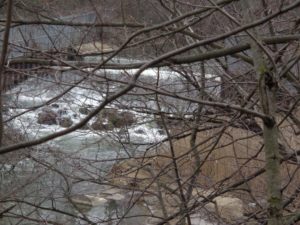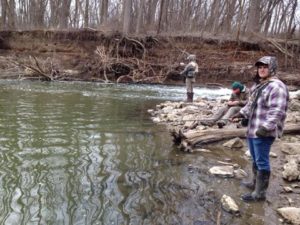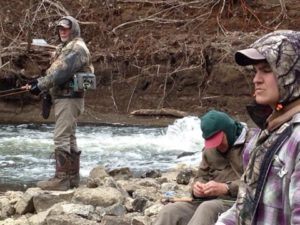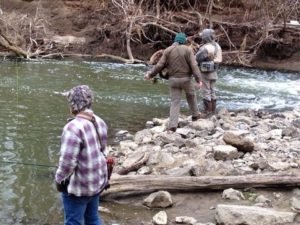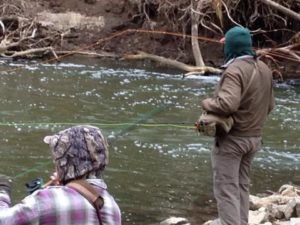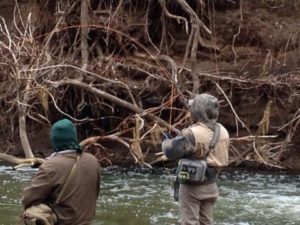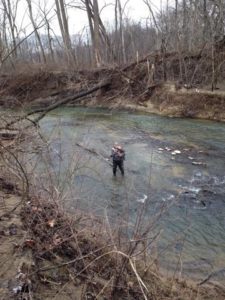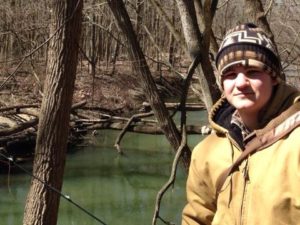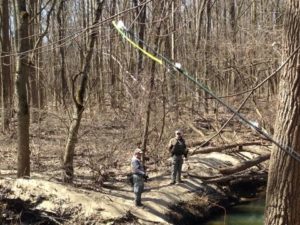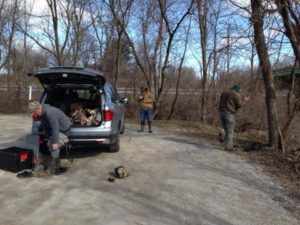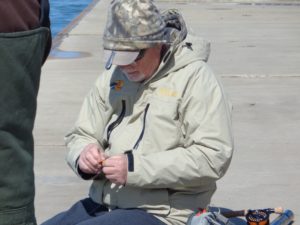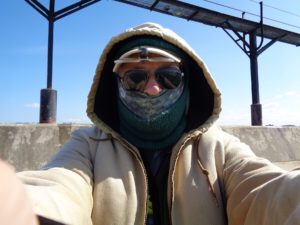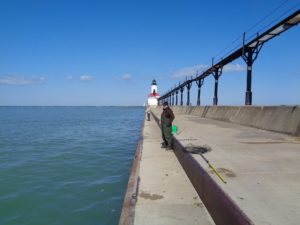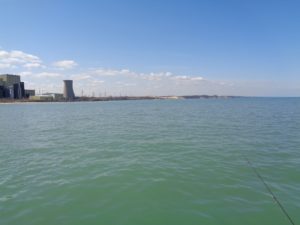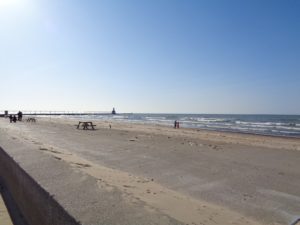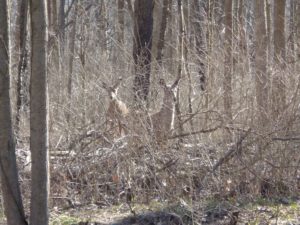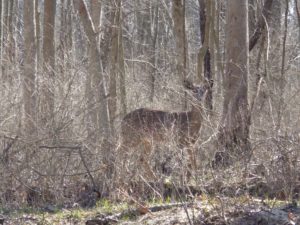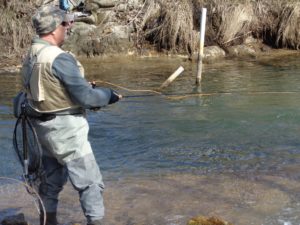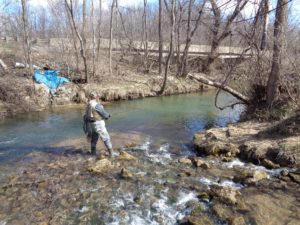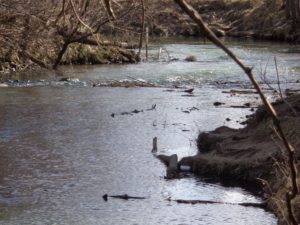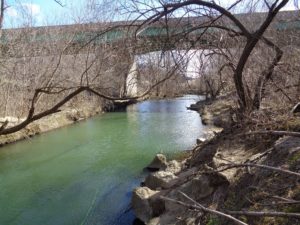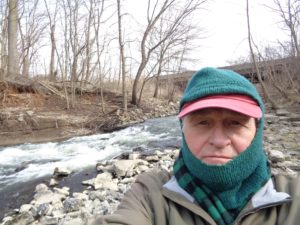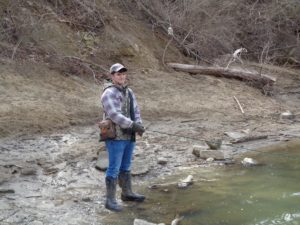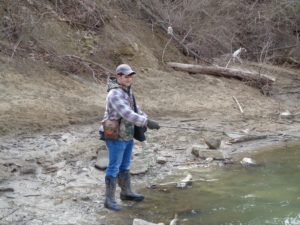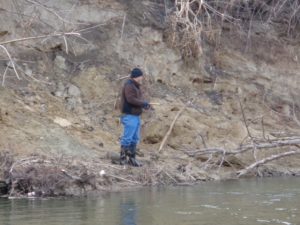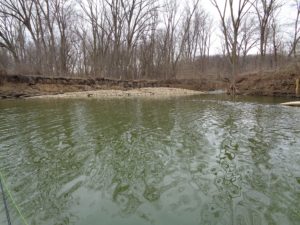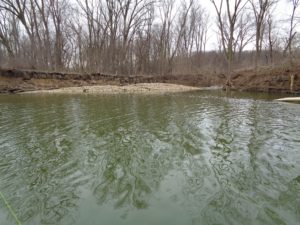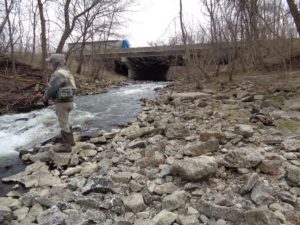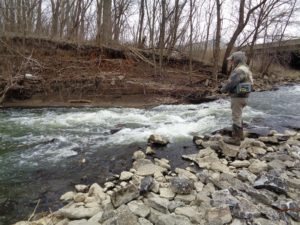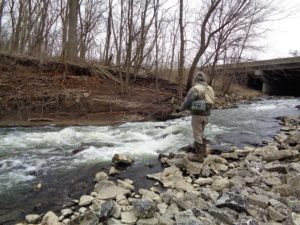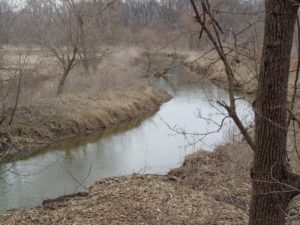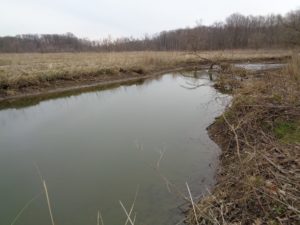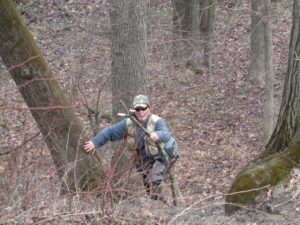April 2018, “Fishing for Steelhead” or “Bob and Larry’s Excellent Adventure”
By Bob Randall on Friday, April 13th, 2018 in Fishing Trip, No Comments
The closest place to Springfield to fish for steelhead is at Indiana Dunes National Lakeshore between Gary, Indiana and Michigan City, Indiana. I had known about it for some time but just couldn’t muster the determination to try it out. One day, my fishing buddy Larry Olson said that a bucket list item for him was to catch steelhead. Now, my excuse to go up there was a reality. I said, “We’re going.”
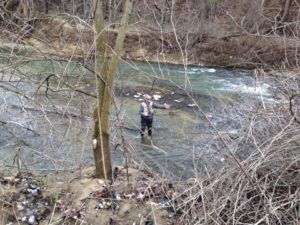
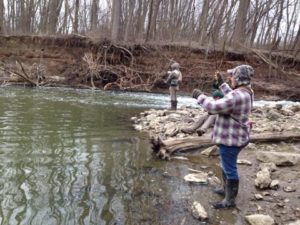
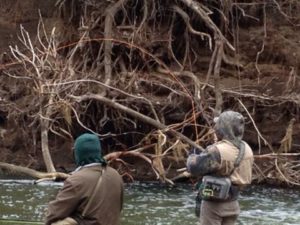
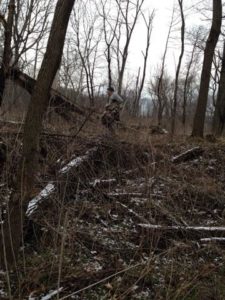
It snowed on the way up, while we were there, and on the way back. There was some sunshine in-between flakes.
I have a good friend, Steve Chorba, who is a park ranger at the Lakeshore. 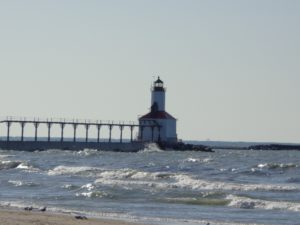 Mt. Baldy, a sand mountain.
Mt. Baldy, a sand mountain. 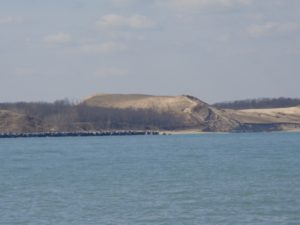
Steve and I were rangers together at the Barataria Preserve in Louisiana, a marsh/swamp section of Jean Lafitte National Historical Park south of New Orleans. That was over 20 years ago and we hadn’t seen each other since. He would be our guide along with his 16 year old son, Luke. 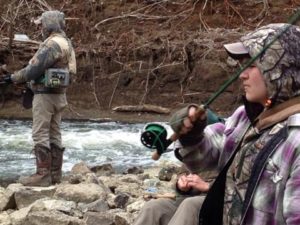
We had a great time catching up, telling stories, and chasing steelhead. We could have taken our bag limit of turkey out his back sliding glass door.
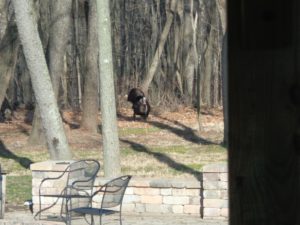
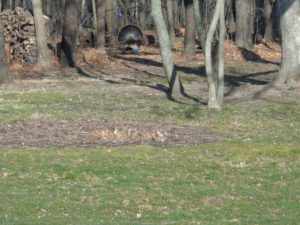
This area was a boggy, marshy area about 15,000 years ago, as the continental glaciers receded. In my mind, it still is although, much of it has been drained for farming, etc. I was amazed at the number of wetland areas we saw. My guess is that the mosquitoes are required by law to have wing numbers. There had been recent rain and snow which diluted the normally turbid water to the point that it was somewhat like the James or Finley Rivers locally. There was no gin clear water like Crane Creek and no free stone rivers like the White. More than once our fly lines were frozen to our rod guides.
Steelhead are an anadromous rainbow trout which are hatched (born, if you prefer) in Lake Michigan tributaries and, at a certain stage in their growth, travel downstream into the lake. They remain there, growing large on the bountiful food sources, then travel back up the tributary where they were born to spawn. Steelhead are not native to Indiana. The state has a stocking program that includes a hybrid steelhead called the “Skamania steelhead trout. The Skamania strain originated from a selective breeding program of early migrating steelhead in Washington state.” There are two steelhead spawns, late winter and summer. No, I don’t think an individual fish spawns twice a year and I don’t know why there are two except that mixing rainbow trout DNA with salmon DNA yields a crazy, mixed up fish that has a warm-water spawn. Wanting to avoid ticks and mosquitoes, we chose the winter run. Someone asked me if they went all the way to the Atlantic. I responded that they might make it, but they would have a hard time jumping Niagara Falls on the return trip to spawn. Unlike some other anadromous salmonids, they do not necessarily die after the spawn but may return to the lake and back again several times during their lives. This area of Indiana also has coho salmon, chinook salmon, brown trout, and other cold-water fish.
For a couple of guys who are used to Missouri trout parks and the tailwaters of the Tablerock dam, this was a different kind of fishing. 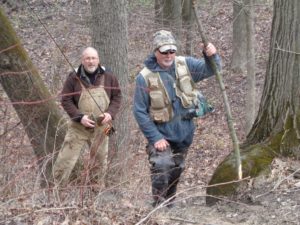
We didn’t do much wading, and casting was limited due to the vegetation and the steep banks. 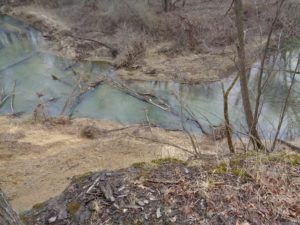
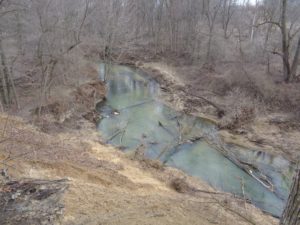 More than once, I looked down a bank and thought to myself that getting down there was one thing but getting back up was another. Several of the public fishing areas only covered a short bit of shoreline or portions were inaccessible down the banks, and a couple
More than once, I looked down a bank and thought to myself that getting down there was one thing but getting back up was another. Several of the public fishing areas only covered a short bit of shoreline or portions were inaccessible down the banks, and a couple 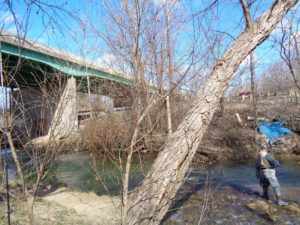 were next to interstate highways. It struck me that a kayak would allow an angler to cover more water.
were next to interstate highways. It struck me that a kayak would allow an angler to cover more water.
We fished the Little Calumet River,  Salt Creek,
Salt Creek, 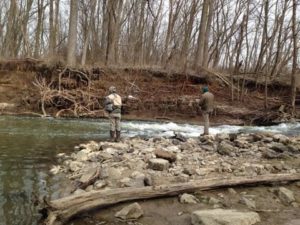
and Trail Creek (both upstream 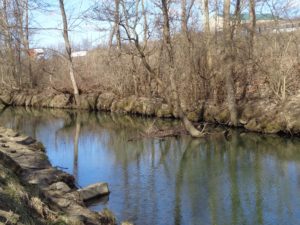 and where it flows into Lake Michigan).
and where it flows into Lake Michigan).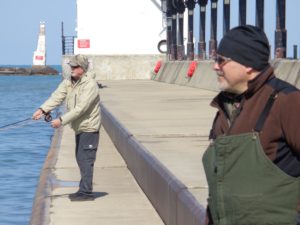
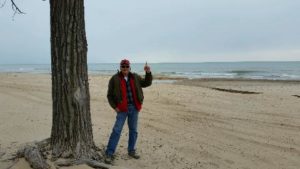 Pointing at the Chicago skyline. It isn’t so bad when reduced to tiny geometric shapes in the distance.
Pointing at the Chicago skyline. It isn’t so bad when reduced to tiny geometric shapes in the distance.
According to the Indiana DNR, in the month of March, 5,243 steelhead had passed through the fish ladder in the St. Joe River at South Bend with over 1,000 of them in the last week. There is a sea lamprey barrier on Trail Creek. It is set up so that while eliminating the lampreys, the USFWS can also count the steelhead caught in the trap. 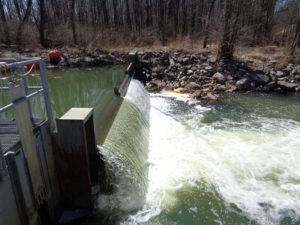
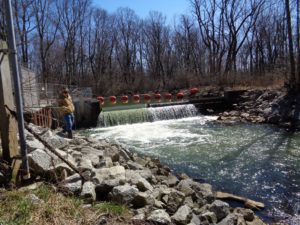 A few also jump the dam.
A few also jump the dam. 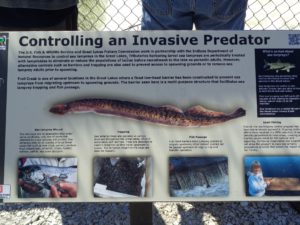 We saw fish the day that we were there but couldn’t fish legally where they were located. I heard from Steve that two days after we were there, thirty steelhead were stacked up below that dam. We fished upstream of that dam. Steve caught a small one.
We saw fish the day that we were there but couldn’t fish legally where they were located. I heard from Steve that two days after we were there, thirty steelhead were stacked up below that dam. We fished upstream of that dam. Steve caught a small one. 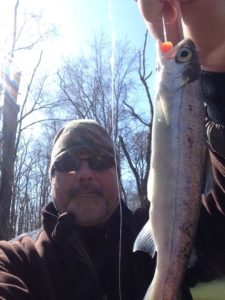 Using the long-arm photo technique, this pip-squeak looks respectable. Larry could see one in the creek but it kept going.
Using the long-arm photo technique, this pip-squeak looks respectable. Larry could see one in the creek but it kept going.
I was taken by surprise by seven deer just across the creek from me. 
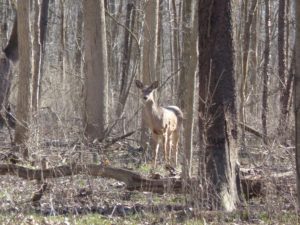 They watched me watching them.
They watched me watching them.
On our last afternoon, we fished a pool below a riffle that held at least three fish. Larry was down at water level and had a fair casting position. I had waded the riffle and could watch from the upper bank about twenty feet above him. I had left my phone and camera in my pack on the other side, so I missed the best picture of the trip. I finally made it down to fish the pool. As I took out the slack in preparation for another roll cast, a fair size steelhead mouthed my black wooly bugger. He took off, jumped out of the water, gave me the evil eye, and spat out my fly. That lasted about half a second but it was a thrill.
I understand that when the water reaches 55 degrees, the steelhead return to the lake. The water temperature was 45 degrees in late March. One of us can attest to that as he fell in the Little Calumet River. We are not saying who this person was, and you can’t make us talk.
One fisherman I talked to, claimed that with the harsh weather, the bulk of the fish were laying back and were in a late spawn cycle. Another told me that we had probably missed the steelhead run by three weeks. So one guy was using the thermometer and the other was using the calendar. I guess, for this trip at least, it doesn’t matter whether we were too early or too late. We were just “too” something. I think a future trip should be planned to have flexible dates which will be pinned down at the last minute based on a report that the steelhead are running hot and heavy. This would require having everything packed and loaded, ready to leave with five minutes notice. This confusion about when the steelhead were running was no different from our local phenomenon concerning the white bass run. I know that several of our MTFA chapter members were planning to slay the white bass coming up from Tablerock Lake into the James River last week. The fish are late due to the cold water and I’ve heard that our people left empty handed. That’s fishing.
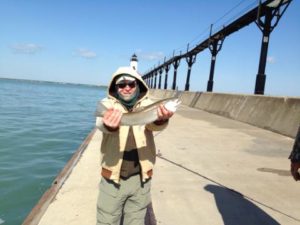 We landed one fish and it was a brown trout.
We landed one fish and it was a brown trout.
If successful fishing is judged solely by catching, then it was a bust. However, I am one of those fishers who considers the adventure, especially when shared with friends, to be the true test of success. We had a great adventure!
